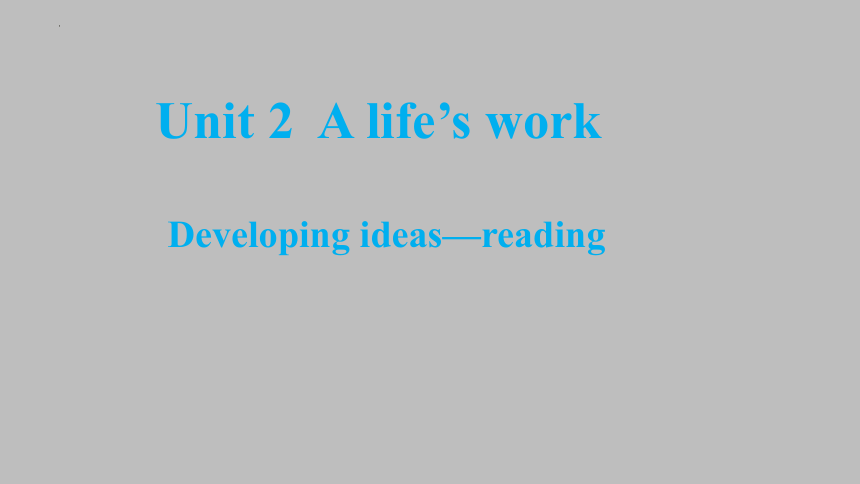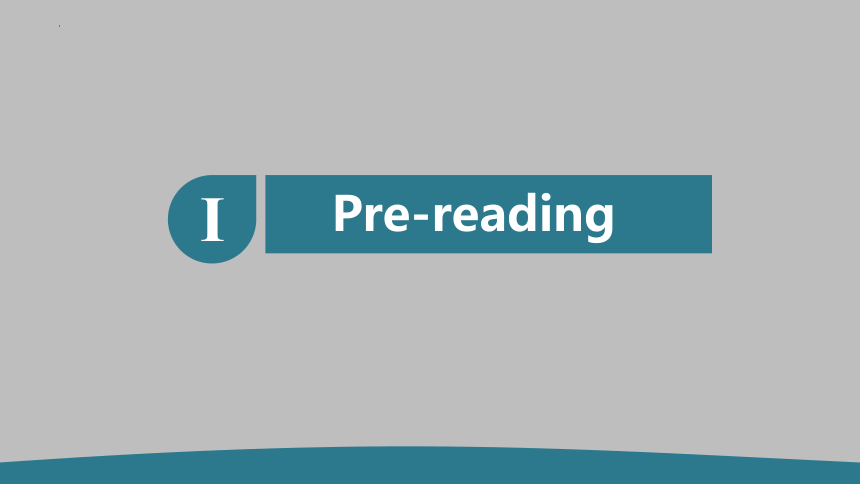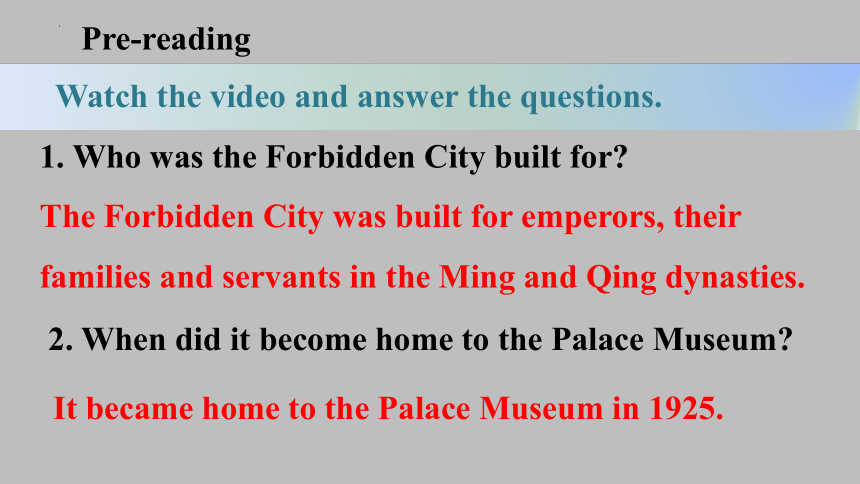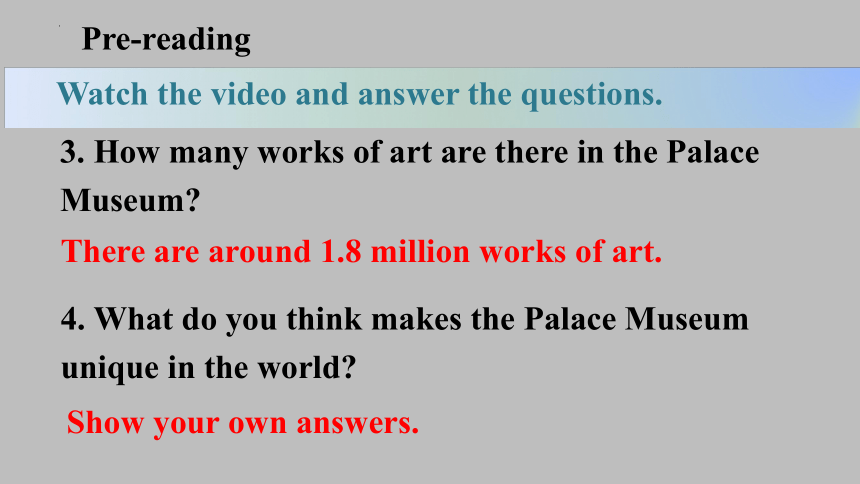外研版(2019) 选择性必修第三册 Unit 2 A life's Work Developing ideas Reading课件(29张)
文档属性
| 名称 | 外研版(2019) 选择性必修第三册 Unit 2 A life's Work Developing ideas Reading课件(29张) |  | |
| 格式 | zip | ||
| 文件大小 | 309.3KB | ||
| 资源类型 | 教案 | ||
| 版本资源 | 外研版(2019) | ||
| 科目 | 英语 | ||
| 更新时间 | 2022-08-03 19:23:38 | ||
图片预览









文档简介
(共29张PPT)
Developing ideas—reading
Unit 2 A life’s work
目录
contents
Pre-reading
I
Language points
Ⅳ
Fast reading
II
Homework
Ⅴ
Intensive reading
III
Post-reading
Ⅵ
I
Pre-reading
Pre-reading
1. Who was the Forbidden City built for
2. When did it become home to the Palace Museum
3. How many works of art are there in the Palace Museum
4. What do you think makes the Palace Museum unique in the world
Watch the video and answer the questions.
Pre-reading
1. Who was the Forbidden City built for
Watch the video and answer the questions.
2. When did it become home to the Palace Museum
The Forbidden City was built for emperors, their families and servants in the Ming and Qing dynasties.
It became home to the Palace Museum in 1925.
Pre-reading
3. How many works of art are there in the Palace Museum
Watch the video and answer the questions.
4. What do you think makes the Palace Museum unique in the world
There are around 1.8 million works of art.
Show your own answers.
Look at the title and the pictures. Predict what the passage is about.
Pre-reading
Show your own answers.
Pre-reading
The Forbidden City is located in the heart of Beijing. Built during the early Ming Dynasty, it is one of the largest imperial palaces in the world. The magnificent halls and walls proudly display the essence and culmination of
Background Information
Pre-reading
traditional Chinese architecture. The Palace Museum was built in it in 1925 and in 1987 the former imperial residence was listed as a UNESCO World Heritage Site.
Background Information
II
Fast reading
a. Why is Wang Jin optimistic about the future of the timepieces in the Palace Museum
b. Why is it painstaking for Wang Jin and his students to repair the collection of timepieces in the Palace Museum
Fast reading
Match the questions to the paragraphs and find out the answers.
c. What has been done to the clocks that date back to the time of Emperor Qianlong
d. Who is Wang Jin and where does he work
e. What qualities do Wang Jin and his colleagues display in their work
Fast reading
Match the questions to the paragraphs and find out the answers.
f. What was special about Wang Jin and his student Qi Haonan
Fast reading
Match the questions to the paragraphs and find out the answers.
a. Why is Wang Jin optimistic about the future of the timepieces in the Palace Museum
Fast reading
(Para. 5) Because he has passed on his skills to a new generation of artisans, who will not only help preserve traditional skills but also bring innovation to the art of clock repairing so that it stands the test of time.
b. Why is it painstaking for Wang Jin and his students to repair the collection of timepieces in the Palace Museum
Fast reading
(Para. 3) Because repairing such a large and important collection of timepieces involves complex work, unique methods of restoration and sourcing difficult-to-find materials, which take a lot of time, care and attention to detail.
c. What has been done to the clocks that date back to the time of Emperor Oianlong
Fast reading
(Para. 4) Wang Jin has spent eight months adjusting the gigantic clock, which is about to be wound up and brought back to life.
d. Who is Wang Jin and where does he work
Fast reading
(Para. 1) He is a clock restoration master, working in Xi San Suo in the Forbidden City.
e. What qualities do Wang Jin and his colleagues display in their work
Fast reading
(Para. 6) They display qualities of skill, patience, modesty and devotion in their work.
f. What was special about Wang Jin and his student Qi Haonan
Fast reading
(Para. 2) They used to be the only two timepiece restorers in the Palace Museum.
III
Intensive reading
Intensive reading
1. What is your understanding of the title, “Masters of Time” What figure of speech does the author use
2. What is your understanding of the sentence, “This is a race against time that can never be won” Do you agree with this Give your reasons.
Discuss and answer the questions.
Intensive reading
3. What do Bill Cunningham and Wang Jin in the two reading passages in this unit have in common
4. What can you do to help to pass on traditional skills and the spirit of craftsmanship
Discuss and answer the questions.
1. What is your understanding of the title, “Masters of Time” What figure of speech does the author use
One possible answer:
The title shows us that those mentioned in the text are all experts skilled at the art of clock repairing.
Intensive reading
I think the author uses the figure of speech (修辞手法) —— metaphor (比喻).
2. What is your understanding of the sentence, “This is a race against time that can never be won” Do you agree with this Give your reasons.
Intensive reading
One possible answer:
The sentence means that the restoration of the clocks will be unlikely to be ever complete.
Answer 1: I agree with this because there is always so much work of clock repairing to do.
Answer 2: I don’t agree with this because the new generations have grown up. Maybe one day, the work will be complete.
3. What do Bill Cunningham and Wang Jin in the two reading passages in this unit have in common
They are both devoted, motivated, passionate and skilled masters in their fields of work.
Intensive reading
4. What can you do to help to pass on traditional skills and the spirit of craftsmanship
Intensive reading
Possible answers:
Pay more attention to traditional skills and cherish the spirit of craftsmanship.
Call on more people to protect and learn the traditional skills.
… (Show your own answers).
Homework
VI
Homework
1. Search the Internet to know more people with the spirit of craftsmanship.
2. Write down your ideas about how to pass on traditional skills and the spirit of craftsmanship.
thank you
VI
Developing ideas—reading
Unit 2 A life’s work
目录
contents
Pre-reading
I
Language points
Ⅳ
Fast reading
II
Homework
Ⅴ
Intensive reading
III
Post-reading
Ⅵ
I
Pre-reading
Pre-reading
1. Who was the Forbidden City built for
2. When did it become home to the Palace Museum
3. How many works of art are there in the Palace Museum
4. What do you think makes the Palace Museum unique in the world
Watch the video and answer the questions.
Pre-reading
1. Who was the Forbidden City built for
Watch the video and answer the questions.
2. When did it become home to the Palace Museum
The Forbidden City was built for emperors, their families and servants in the Ming and Qing dynasties.
It became home to the Palace Museum in 1925.
Pre-reading
3. How many works of art are there in the Palace Museum
Watch the video and answer the questions.
4. What do you think makes the Palace Museum unique in the world
There are around 1.8 million works of art.
Show your own answers.
Look at the title and the pictures. Predict what the passage is about.
Pre-reading
Show your own answers.
Pre-reading
The Forbidden City is located in the heart of Beijing. Built during the early Ming Dynasty, it is one of the largest imperial palaces in the world. The magnificent halls and walls proudly display the essence and culmination of
Background Information
Pre-reading
traditional Chinese architecture. The Palace Museum was built in it in 1925 and in 1987 the former imperial residence was listed as a UNESCO World Heritage Site.
Background Information
II
Fast reading
a. Why is Wang Jin optimistic about the future of the timepieces in the Palace Museum
b. Why is it painstaking for Wang Jin and his students to repair the collection of timepieces in the Palace Museum
Fast reading
Match the questions to the paragraphs and find out the answers.
c. What has been done to the clocks that date back to the time of Emperor Qianlong
d. Who is Wang Jin and where does he work
e. What qualities do Wang Jin and his colleagues display in their work
Fast reading
Match the questions to the paragraphs and find out the answers.
f. What was special about Wang Jin and his student Qi Haonan
Fast reading
Match the questions to the paragraphs and find out the answers.
a. Why is Wang Jin optimistic about the future of the timepieces in the Palace Museum
Fast reading
(Para. 5) Because he has passed on his skills to a new generation of artisans, who will not only help preserve traditional skills but also bring innovation to the art of clock repairing so that it stands the test of time.
b. Why is it painstaking for Wang Jin and his students to repair the collection of timepieces in the Palace Museum
Fast reading
(Para. 3) Because repairing such a large and important collection of timepieces involves complex work, unique methods of restoration and sourcing difficult-to-find materials, which take a lot of time, care and attention to detail.
c. What has been done to the clocks that date back to the time of Emperor Oianlong
Fast reading
(Para. 4) Wang Jin has spent eight months adjusting the gigantic clock, which is about to be wound up and brought back to life.
d. Who is Wang Jin and where does he work
Fast reading
(Para. 1) He is a clock restoration master, working in Xi San Suo in the Forbidden City.
e. What qualities do Wang Jin and his colleagues display in their work
Fast reading
(Para. 6) They display qualities of skill, patience, modesty and devotion in their work.
f. What was special about Wang Jin and his student Qi Haonan
Fast reading
(Para. 2) They used to be the only two timepiece restorers in the Palace Museum.
III
Intensive reading
Intensive reading
1. What is your understanding of the title, “Masters of Time” What figure of speech does the author use
2. What is your understanding of the sentence, “This is a race against time that can never be won” Do you agree with this Give your reasons.
Discuss and answer the questions.
Intensive reading
3. What do Bill Cunningham and Wang Jin in the two reading passages in this unit have in common
4. What can you do to help to pass on traditional skills and the spirit of craftsmanship
Discuss and answer the questions.
1. What is your understanding of the title, “Masters of Time” What figure of speech does the author use
One possible answer:
The title shows us that those mentioned in the text are all experts skilled at the art of clock repairing.
Intensive reading
I think the author uses the figure of speech (修辞手法) —— metaphor (比喻).
2. What is your understanding of the sentence, “This is a race against time that can never be won” Do you agree with this Give your reasons.
Intensive reading
One possible answer:
The sentence means that the restoration of the clocks will be unlikely to be ever complete.
Answer 1: I agree with this because there is always so much work of clock repairing to do.
Answer 2: I don’t agree with this because the new generations have grown up. Maybe one day, the work will be complete.
3. What do Bill Cunningham and Wang Jin in the two reading passages in this unit have in common
They are both devoted, motivated, passionate and skilled masters in their fields of work.
Intensive reading
4. What can you do to help to pass on traditional skills and the spirit of craftsmanship
Intensive reading
Possible answers:
Pay more attention to traditional skills and cherish the spirit of craftsmanship.
Call on more people to protect and learn the traditional skills.
… (Show your own answers).
Homework
VI
Homework
1. Search the Internet to know more people with the spirit of craftsmanship.
2. Write down your ideas about how to pass on traditional skills and the spirit of craftsmanship.
thank you
VI
